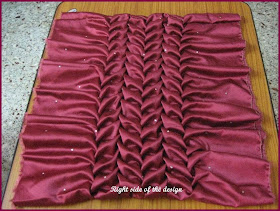 | ||||
Smocking is done on pairs of columns marked with diagonals together. After completing one pair of column we have to move on to the next pair.
Width of the material after smocking

After smocking the width of one pair of column of squares become equal to ½ if the diagonal of the square used.he gap takes the shape of an equilateral triangle (See the diagram 1) whose side is equal to the diagonal of the square. Width of the gap will be equal to the height of the triangle thus formed.
Height of the triangle can be calculated by using the diagonal of the square used
Height of the triangle =√ (diagonal²–½diagonal²) .No need to worry about the formula. I have given the table which gives the diagonal and height of the triangle formed when smocking is done on different sizes of squares.

Length
After smocking the height of two rows will be equal to the diagonal of the square
With the help of these calculations we can find out the number of squares we need in each row and in each column. And then the material needed..Figures3,4and 5 explain the changes that take place after smocking for different sizes of squares



I will give one example
How to calculate material needed for a cushion of size 40cm x40cm smocking done on graph with squares 3cm x 3cm
Width
After smocking width first column becomes half of the diagonal =2.1cm
Width of next gap will be equal to height of the triangle formed = 3.6cm
Total of these three squares will be 5.7cm
These three squares are repeated
Last column is column of squares with diagonals (marked pink) its width is 2.1cm
Subtract 2.1 cm from 40 cm =37.9 cm
Now we have to find out how many times the fist 3 squares whose width will be 5.7 can be repeated to get to get 37.9cm
37.9cm÷ 5.7= 6.6
We can repeat 6 times without fraction that means we have to repeat 3 squares 6 times
3x6= 18 squares + last column 2 squares. = 20 squares
If you smock on 20 squares resulting material will be (8x 5.7) + 2.1= 34.2 cm + 2.1cm= 36.3 cm
It is 37 cm approximately or 4cm less than 40 cm this can be made up by adding 2 cm on either side as border to this add 1cm on either side for seams
Length
We get 4, 2 cm when we smock 2 rows
These two rows should be repeated 40 ÷ 4.2= 9.5 times or 9 times without taking decimal
2 rows X 9 = 18 rows. When we smock these 18 rows the length we get = 4.2 x 9= 37.8 cm
It is 2.2 cm less than 40 cm. it can be made up by adding 1 .1 cm on either side. To this add 1 cm on either side as border.
So the graph will have 18 rows each row having 20 squares
Width of the material=20 squares x 3cm=60cm + 6cm=66cm
Length of the material = 18 X 3 cm =54 cm + 4.2 cm=56.2 cm
Material needed =66 cm Χ 56.2 cm





















 ..
.. 












